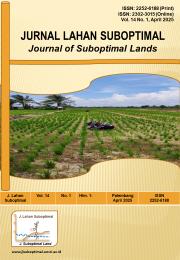Integration of geographical information systems in the land suitability assessment for rice crops in Sleman District, Indonesia
DOI:
https://doi.org/10.36706/jlso.14.1.2025.728Keywords:
geography information system, land potential, land suitability, regional planning, rice plantsAbstract
Peatlands (according to the Governmental Regulation nr 71/2014) can be utilized for agriculture and plantation if the peat depths are less than 3 m or more than 3 m, peatlands have to be conserved or restored. Determining peat depths can be conducted in the fields by intensive surveys which were so expensive, inefficient, and ineffective, therefore it was essential to find our simple alternative methods how to measure peat depths easily. The research aimed to establish a spatially reliable interpolator for peat depth variability by utilizing the kriging method. The research was conducted in Seponjen Village, Kumpeh, Muaro Jambi, Jambi Indonesia. Primary data were processed by applying ArcGIS 10.3 software. The interpolated dataset of peat depths validated their actual dataset and performed an excellent relationship (indicated by a positive correlation coefficient, r = 0.920) and a coefficient of determination (R2 = 0.847). It indicated that the interpolated dataset could be utilized to make maps by kriging. The very deep peat (Site A) and the deep peat (Site B) showed a tendency for a strong autocorrelation of the data distribution of peat depths. Autocorrelation tended to be anisotropic towards the river on the shallow peat (Site C). A good interpolator of peat depth variability can be generated using the kriging method.
References
Abdelrahman, M. A. E., Natarajan, A., & Hegde, R. (2016). Assessment of land suitability and capability by integrating remote sensing and GIS for agriculture in Chamarajanagar district, Karnataka, India. Egyptian Journal of Remote Sensing and Space Science, 19(1), 125–141. https://doi.org/10.1016/j.ejrs.2016.02.001
Abdullah, N., Zolkafli, A., Mansor, N. S., & Chik, N. A. (2020). Farmer’s knowledge in land suitability evaluation and farmers’ awareness in organic farming for sustainable agriculture: A case study in perlis. IOP Conference Series: Earth and Environmental Science, 616(1). https://doi.org/10.1088/1755-1315/616/1/012041
Akpoti, K., Kabo-bah, A. T., & Zwart, S. J. (2019). Agricultural land suitability analysis: State-of-the-art and outlooks for integration of climate change analysis. Agricultural Systems, 173(January 2018), 172–208. https://doi.org/10.1016/j.agsy.2019.02.013
Albaji, M., & Alboshokeh, A. (2017). Assessing agricultural land suitability in the Fakkeh region, Iran. Outlook on Agriculture, 46(1), 57–65. https://doi.org/10.1177/0030727017690659
Asmarhansyah, A., B Badayos, R., B Sanchez, P., C Sta Cruz, P., & M Florece, L. (2017). Land suitability evaluation of abandoned tin-mining areas for agricultural development in Bangka Island, Indonesia. Journal of Degraded and Mining Lands Management, 04(04), 907–918. https://doi.org/10.15243/jdmlm.2017.044.907
Bilas, G., Karapetsas, N., Gobin, A., Mesdanitis, K., Toth, G., Hermann, T., Wang, Y., Luo, L., Koutsos, T. M., Moshou, D., & Alexandridis, T. K. (2022). Land suitability analysis as a tool for evaluating soil-improving cropping systems. Land, 11(12). https://doi.org/10.3390/land11122200
Bozdağ, A., Yavuz, F., & Günay, A. S. (2016). AHP and GIS based land suitability analysis for Cihanbeyli (Turkey) County. Environmental Earth Sciences, 75(9). https://doi.org/10.1007/s12665-016-5558-9
Deka, I. C., & Rashmi, K. I. (2015). Land suitability analysis for identification of summer paddy cultivation sites based on multi criteria evaluation through GIS KALYANJIT SARMAH project scientist assam remote sensing application centre (ARSAC) senior scientific officer assam remote sensing. European Academic Research, 2(10), 13584–13606. www.euacademic.org
Dharumarajan, S., Kalaiselvi, B., Lalitha, M., Vasundhara, R., & Hegde, R. (2022). Defining fertility management units and land suitability analysis using digital soil mapping approach. Geocarto International, 37(20), 5914–5934. https://doi.org/10.1080/10106049.2021.1926553
Kadam, A., M, R., Umrikar, B., Bhagat, V., Wagh, V., & Sankua, R. N. (2021). Land suitability analysis for afforestation in semi-arid watershed of Western Ghat, India: A Groundwater Recharge Perspective. Geology, Ecology, and Landscapes, 5(2), 136–148. https://doi.org/10.1080/24749508.2020.1833643
Karimi, F., Sultana, S., Shirzadi Babakan, A., & Royall, D. (2018). Land suitability evaluation for organic agriculture of wheat using GIS and multicriteria analysis. Papers in Applied Geography, 4(3), 326–342. https://doi.org/10.1080/23754931.2018.1448715
Li, Q., Huang, J., Wang, C., Lin, H., Zhang, J., Jiang, J., & Wang, B. (2017a). Land development suitability evaluation of pingtan Island based on scenario analysis and landscape ecological quality evaluation. Sustainability (Switzerland), 9(7), 14–19. https://doi.org/10.3390/su9071292
Li, G., Messina, J. P., Peter, B. G., & Snapp, S. S. (2017b). Mapping land suitability for agriculture in Malawi. Land Degradation and Development, 28(7), 2001–2016. https://doi.org/10.1002/ldr.2723
Makhamreh, Z. (2019). Land degradation vulnerability assessment based on land use changes and fao suitability analysis in Jordan. Spanish Journal of Soil Science, 9(2), 125–141. https://doi.org/10.3232/SJSS.2019.V9.N2.05
Montgomery, B., Dragićević, S., Dujmović, J., & Schmidt, M. (2016). A GIS-based Logic Scoring of Preference method for evaluation of land capability and suitability for agriculture. Computers and Electronics in Agriculture, 124, 340–353. https://doi.org/10.1016/j.compag.2016.04.013
Mugiyo, H., Chimonyo, V. G. P., Sibanda, M., Kunz, R., Masemola, C. R., Modi, A. T., & Mabhaudhi, T. (2021). Evaluation of land suitability methods with reference to neglected and underutilised crop species: A scoping review. Land, 10(2), 1–24. https://doi.org/10.3390/land10020125
Mulyani, A., Mulyanto, B., Barus, B., Panuju, D. R., & Husnain. (2023). Potential land reserves for agriculture in Indonesia: suitability and legal aspect supporting food sufficiency. Land, 12(5). https://doi.org/10.3390/land12050970
Nasution, Y., Rasyidin, A., Yulnafatmawita, & Saidi, A. (2019). Evaluation of Salacca sumatrana as soil conservation crop in south tapanuli, north sumatra, Indonesia. Biodiversitas, 20(3), 664–670. https://doi.org/10.13057/biodiv/d200307
Neswati, R., Baja, S., & Lopulisa, C. (2021). A modification of land suitability requirements for maize in the humid tropics of South Sulawesi. IOP Conference Series: Earth and Environmental Science, 921(1). https://doi.org/10.1088/1755-1315/921/1/012012
Paul, M., Negahban-Azar, M., Shirmohammadi, A., & Montas, H. (2020). Assessment of agricultural land suitability for irrigation with reclaimed water using geospatial multi-criteria decision analysis. Agricultural Water Management, 231(April 2019), 105987. https://doi.org/10.1016/j.agwat.2019.105987
Pimenta, F. M., Speroto, A. T., Costa, M. H., & Dionizio, E. A. (2021). Historical changes in land use and suitability for future agriculture expansion in Western Bahia, Brazil. Remote Sensing, 13(6), 1–31. https://doi.org/10.3390/rs13061088
Priyadharshini, S., Jegankumar, R., & Aruchamy, S. (2019). Land suitability evaluation for paddy cultivation using GIS for Sweta Nadi Basin, Tamil Nadu, India. Int j Innov Stud Social, 4931(February), 82–89.
Rasheed, H., & Naz, A. (2017). Modeling the rice land suitability using GIS and multi-criteria decision analysis approach in Sindh, Pakistan. Journal of Basic & Applied Sciences, 13, 26–33.
Romadhona, S., Mutmainnah, L., Wibowo, C., & Setiawati, T. C. (2020). Assessment of coastal vulnerability index on potential agricultural land-CVI, Banyuwangi Regency.” E3S Web of Conferences, 142, 1–8. https://doi.org/10.1051/e3sconf/202014201002
Romadhona, S., Puryono, S., Rachmawati, S., & Sciences, N. (2024). Holistic Sustainability Assessment of Certified Organic, NonCertified Organic, and Non-Organic Rice Farming Practices Using SAFA Framework in Sleman Regency, Indonesia. 10(2), 256–278.
Sappe, N. J., Baja, S., Neswati, R., & Rukmana, D. (2022). Land suitability assessment for agricultural crops in Enrekang, Indonesia: combination of principal component analysis and fuzzy methods. Sains Tanah, 19(2), 165–179. https://doi.org/10.20961/stjssa.v19i2.61973
Singha, C., & Swain, K. C. (2016). Land suitability evaluation criteria for agricultural crop selection: A review. Agricultural Reviews, 37(2), 125–132. https://doi.org/10.18805/ar.v37i2.10737
Sofyan, R., Wahyunto, Agus, F., & Hidayat, H. (2007). Land suitability evaluation guide. Balai Penelitian Tanah Dan World Agroforestry Centre, 48.
Sumani, Mujiyo, Winarno, J., Widijanto, H., & Hasanah, K. (2018). Land suitability evaluation for sweet corn in third cropping period at Wonosari Village, Karanganyar, Indonesia. IOP Conference Series: Earth and Environmental Science, 200(1). https://doi.org/10.1088/1755-1315/200/1/012007
Widiatmaka, W., Ambarwulan, W., Firmansyah, I., Munibah, K., Santoso, P. B. K., & Sudarsono, S. (2014). Land suitability and dynamic system modelling to define priority areas of soybean plantation in paddy fields in Karawang, West Java. Agrivita, 36(3), 235–248. https://doi.org/10.17503/Agrivita-2014-36-3-235-248
Wondimu, G. H., & Ayansa, W. A. (2022). Land suitability evaluation for moringa oleifera tree using GIS and AHP techniques in Weyieb Sub Basin, Ethiopia. Journal of Plant Sciences, 10(3), 106–118. https://doi.org/10.11648/j.jps.20221003.14
Yalew, S. G., van Griensven, A., Mul, M. L., & van der Zaag, P. (2016). Land suitability analysis for agriculture in the Abbay basin using remote sensing, GIS and AHP techniques. Modeling Earth Systems and Environment, 2(2), 1–14. https://doi.org/10.1007/s40808-016-0167-x
Downloads
Published
How to Cite
Issue
Section
License
Copyright (c) 2025 Sukron Romadhona, Sri Puryono, Mussadun Mussadun

This work is licensed under a Creative Commons Attribution-NonCommercial-ShareAlike 4.0 International License.













